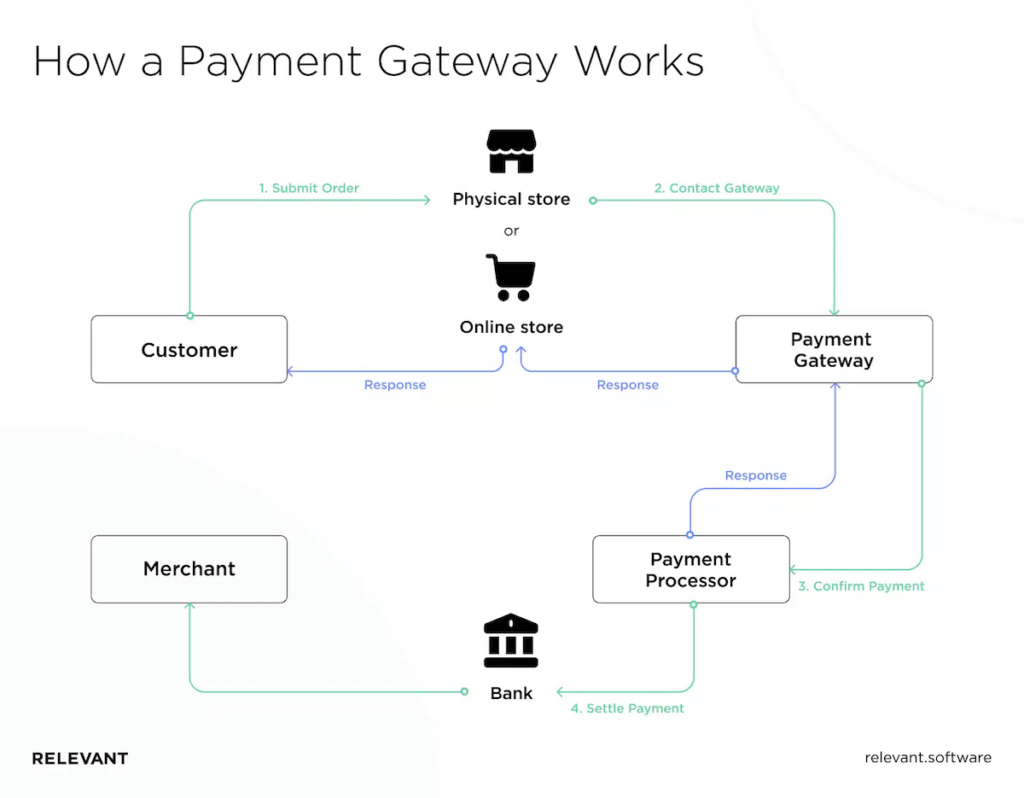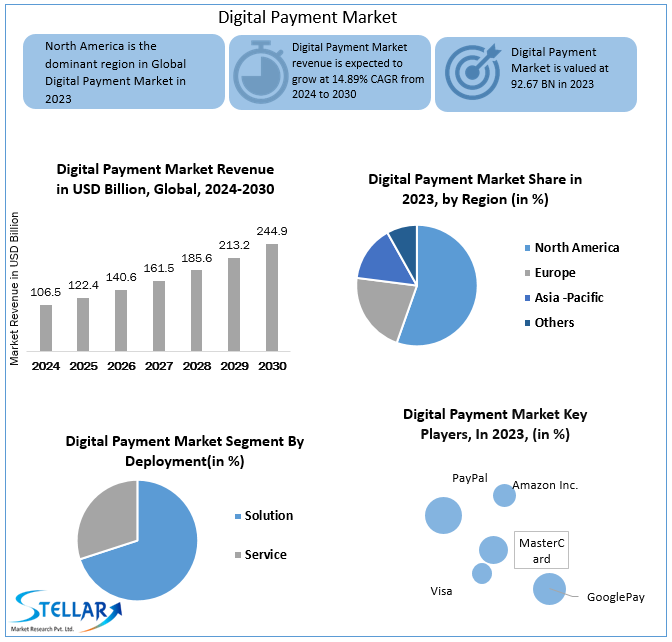How to Integrate Payment Gateway: A Basic Tutorial for Online Stores
By 2023, over 2 billion individuals have bought something online at least once, which highlights just how vast and available e-commerce has become. Businesses must build a payment gateway into their app or website to handle these electronic payments, including credit or debit card transactions. The great thing is that payment technologies have advanced to the point where integration can be incredibly straightforward. Let’s explain how to integrate payment gateway and steer you through the details of the process. You can either tackle this yourself or seek help from a fintech software development company.
Table of Contents
What Is a Payment Gateway? The Basics
A payment gateway is a technology tool that acts as the go-between for electronic payments to make it possible for both physical and online stores to securely accept various payment methods like credit cards and digital wallets. It connects customers, businesses, and banks during transactions. What a payment gateway does includes:

We provide companies with senior tech talent and product development expertise to build world-class software. Let's talk about how we can help you.
Contact us- Encryption: It secures customer payment information from the moment it’s entered at checkout until it reaches the bank.
- Connection: It links the checkout process with the payment processor.
- Authorization: It sends transaction data to the bank for approval, ensuring the customer has enough funds.
- Reporting: It offers businesses insights on transactions, refunds, and trends for better management.
- Fraud Prevention: It employs tools like fraud detection algorithms to block suspicious activities.
In short, payment gateways ensure fast, secure, and smooth payments, offer insights, and provide security against fraud.

Types of Payment Gateways
Payment gateways fall into one of two categories.
Hosted Payment Gateways take your customer off your site’s checkout page. When they’re ready to pay, they’re moved to the payment service provider’s site to input their payment information. After the transaction is complete, the customer is sent back to your website. PayPal is a classic example of this. The main advantage here is that the service provider handles the security and payment processing, which reduces your workload and compliance requirements.
Non-hosted or on-site payment gateways keep your customers on your website during the payment process. Businesses that have their own payment gateway directly integrated into their website offer a seamless checkout experience. This option offers more control over the user experience but also introduces the responsibility to ensure transaction security and compliance with Payment Card Industry (PCI) standards.
Sometimes, businesses opt for a white-label payment gateway as an alternative to a non-hosted payment gateway solution. These pre-made solutions can be personalized and branded, as PayXpert and Akurateco have done.
Related – Payment Gateway Development: What You Need to Know
Advantages of Using a Payment Gateway
Incorporation of an online payment gateway into your business operations can significantly benefit your business in several ways:
- Enhanced Security: Payment gateways adhere to strict security standards to protect sensitive financial information. Encryption helps reduce the risks of fraud and breaches, giving both businesses and consumers peace of mind.
- Expanded Customer Base: Businesses can attract customers from different locations by accepting various forms of online payments. This global reach benefits e-commerce sites that aim to broaden their market presence.
- Improved Customer Experience: Payment gateways offer a smoother, faster checkout process, which can enhance the overall shopping experience. Customers who can pay quickly and easily are more likely to be satisfied and return for more.
- Efficient Transactions: Automated systems for payment processing via gateways enhance speed and efficiency compared to traditional manual methods. It reduces the likelihood of errors and speeds up the transaction process, enabling businesses to function more smoothly.
- Compliance and Trust: Compliance with PCI standards helps build trust with your customers. The assurance that their payment information receives secure handling encourages customers to transact with your business.
In simple terms, online payment gateways are super important for running e-commerce smoothly. When you pick the right one and use its advantages, you really boost your business and keep customers happy.

Source: Stellarmr
Best Payment Gateways for App Integration
Before we dive into how to integrate payment gateway into a website or mobile app, let’s explore some of the top service providers in the market.
| Payment Gateway | Features | Best For | Fee |
| Stripe | Comprehensive API, Global Support | Global businesses, tech-savvy startups | 2,9% +$0.30 per transaction |
| PayPal | Wide acceptance, Buyer protection | Small to medium businesses, e-commerce | 2,9% +$0.30 per transaction |
| Square | Integrated POS system, Easy setup | Retail, in-person, and online sales | 2.6% + $0,10 for most in-person transactions |
| Braintree | PayPal subsidiary, Advanced fraud protection | Businesses that need robust security | 2,9% +$0.30 per transaction |
| Apple Pay/Google Pay | Faster checkout, secure transactions | Businesses with Android (iOS) user base | No direct fees. Transaction fees depend on your chosen payment gateway. |
Related – Building Payment Systems Based on Distributed Architecture
How to Integrate Payment Gateway: Stepwise
Integration of an online payment gateway into your online business setup is critical for enabling secure and efficient financial transactions. Here’s how you can do it straightforwardly.
Choose the Payment Gateway
When you select a payment gateway, consider two main factors: scalability and security. You want a gateway that can grow with your business and handle increasing transaction volumes without a hitch. Equally important is the security it offers, as it needs to protect sensitive financial data.
Also, pay attention to the fees involved. Different gateways offer various pricing models, which include transaction fees, monthly fees, and setup fees. Seek a harmony between price and necessary features. Also, consider the variety of payment methods supported, the simplicity of system integration, and the level of customer service the provider delivers.
Consider Technical Requirements
Before you integrate a payment gateway, you must ensure your website is technically prepared. One critical requirement is an SSL certificate, which encrypts data between the customer’s browser and your server, adding a layer of security to transactions.
Another factor to think about is the platform your website uses. Certain gateways offer plugins or extensions for popular e-commerce systems like Shopify or WooCommerce, which smooths the integration process. If you have a custom-built site, you should collaborate closely with developers to ensure compatibility.
Set Up a Merchant Account
The payment gateway you select might require the creation of a merchant account. This particular bank account enables your business to process payments made with credit and debit cards. The process requires providing detailed business information, financial history, and a credit check. Some options offer a combined service, integrating the merchant account and gateway to simplify the setup process.
Bear in mind: This explanation is streamlined, and the precise requirements and steps can differ based on the payment gateway selected.

The Integration Process
Payment gateway integration is a crucial step for businesses that aim to accept online payments, whether through a website or a mobile app. Let’s break down this process.
For Websites
- Pick a Payment Gateway: Opt for one that aligns with your business requirements, considering cost, accepted payment methods, and security capabilities.
- Sign Up and Get API Keys: After choosing a gateway, sign up for an account and obtain API keys, which will allow your website to communicate with the payment gateway.
- Integration: Use the provided SDKs (Software Development Kits) or APIs (Application Programming Interfaces) for payment gateway integration into your website. This payment gateway API integration might require developer skills or assistance.
- Configure Payment Methods: Set up the types of payments you want to accept (e.g., credit cards, PayPal, bank transfers).
For Mobile Apps
- Choose a Mobile-Friendly Gateway: Choose a payment gateway that offers robust support for mobile apps. Look for features like payment gateway API integration that can handle the unique challenges of mobile platforms.
- Obtain SDKs and Integrate into App: Most gateways provide Software Development Kits (SDKs) that simplify integrating their service into your app. This is where your developers come in, using the SDK to blend the payment gateway naturally into your app’s flow.
- Test on Devices: Use the gateway’s testing environment to ensure the payment process is bulletproof. This helps catch any issues before your customers do.
- Launch and Monitor: After thorough testing, launch the payment feature. Keep an eye on transactions and user feedback to quickly address any concerns that arise.
Personalize the Payment Experience
This means you tailor the payment process to be both on-brand and smooth. It’s about tweaking the appearance and functionality of the payment gateway to align with your business’s vibe and your customers’ expectations.
Customize Checkout Pages
You can use the customization options provided by the payment gateway to aligning the look and feel of the checkout page with your branding. Some gateways offer more flexibility than others, so consider this when choosing your payment gateway integration services provider.
Test the Payment Process
Ensure you rigorously evaluate the payment procedure in a sandbox setting before launching it publicly. This is a safe space where you can simulate transactions without moving real money. Testing helps ensure that the payment flow is smooth, secure, and user-friendly, and it allows you to catch and fix any issues before customers are affected.
To reduce the total customer effort for payment, try to simplify the entire journey. Eliminate unnecessary steps and minimize the number of forms required during checkout. Explore options like one-click payment or guest checkout features to expedite transactions for returning and first-time customers.
Vadim Struk, product manager at Relevant Software
Security Measures
When you add a payment gateway to your app, remember – security is key. You’ve got to keep customer information safe and ensure all transactions go through securely.
Encrypt Transaction Data
Always prioritize the use of encryption and tokenization techniques for all payment transactions. Encryption converts sensitive data into a secure format that can only be read with a decryption key, while tokenization replaces sensitive information with non-sensitive equivalents, keeping the essential details without risking security.
Comply with Data Protection Regulations
Staying in line with laws like GDPR isn’t just about avoiding fines; it shows your customers that you respect their privacy. Ensure your payment process adheres to these laws by obtaining consent where necessary, being transparent about data usage, and securing customer data against breaches.
Regularly review and update your security protocols to keep up with the latest standards and mitigate emerging threats.
Vadim Struk, product manager at Relevant Software
Troubleshooting and Support
Effective troubleshooting and support play crucial roles in the integration and maintenance of a payment gateway. No system is perfect, and you’re likely to encounter challenges along the way.
Common Integration Issues
Common challenges include incorrect API implementation, compatibility issues with web or mobile platforms, and payment declines due to security features. Address these issues through documentation review, SDK or API updates, and consulting the gateway’s support team for specific problems.
Monitor and Maintain Your App
Regular monitoring and maintenance are essential to ensure the payment gateway functions smoothly. Ensure your integration stays current with the newest security enhancements and software upgrades. Additionally, monitor the success rates of transactions and listen to customer feedback closely to swiftly resolve any arising concerns.
It’s wise to have backup systems in place. This way, if your primary service faces downtime, you can switch to a spare, minimizing any disruption to your users.
Vadim Struk, product manager at Relevant Software
Related – Building Payment Systems Based on Distributed Architecture
Our Case Studies
Let’s dive into two real-world examples: Optimum Pay Group (OPG) and FISK, where we see firsthand the transformation that comes when you match a business’s unique needs with innovative, customized payment technologies.
OPG (Optimum Pay Group)
Optimum Pay Group, an award-winning global fintech powerhouse in 2019 and 2020, faced a challenge: their existing third-party payroll system was holding back their growth. And they hired us with a mission to transform this bottleneck into an opportunity.
A dedicated Relevant team coped with this task perfectly and developed a secure, web-accessible payroll and accounting software from scratch, featuring user management, a staff dashboard, a streamlined registration process, and detailed reports. This custom solution for Optimum Pay Group’s needs positions them for continued expansion and success in the payroll services market.
FISK
The CEO of 55th Degree approached Relevant to develop fintech software. The goal was to create an MVP for an innovative platform that combines automated investing with virtual card tipping. This feature gives users immediate control and use of their tips. The main challenge involved integrating various financial APIs for KYC, card issuing, and bank connections, such as Plaid and Stripe.
Our team rolled out a fully functional MVP right on schedule and within our budget, packed with features such as investment choices, simple QR code money transfers, and secure linking of various bank and brokerage accounts. This project was 55th Degree’s first leap into the digital product space, laying a solid foundation for growth ahead.
Integrate a Payment Gateway with Relevant
Ready to turbocharge your business with top-notch payment gateway integration services? At Relevant Software, we specialize in customizing payment gateways to boost your transactions, ramp up security, and elevate the user experience, as seen in our successful OPG and FISK projects.
Our comprehensive suite of software development services (e-commerce, retail, etc) equips you to address any technological challenge. With the option to bring on board skilled remote developers, you can harness the power of IT outsourcing at your convenience.
Initiate your journey towards innovation — reach out to us!
Our core services:
Do you want a price estimate for your project?
Do you know that we helped 200+ companies build web/mobile apps and scale dev teams?
Let's talk about your engineering needs.
Write to us











